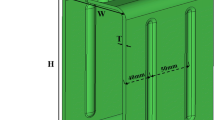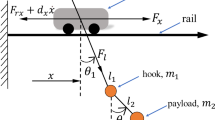Abstract
Hydraulic brake was widely used for mechanical brake of port crane. The run-state of the brake affects the safety of the crane because of the sudden accident. Because of the complex structure and unsuited to use in real time of traditional assessment model, the condition assessment approach of hydraulic brake was constructed based on state estimation algorithm in this paper. The oil temperature, dynamic friction coefficient, spring stiffness coefficient, brake shoe clearance and contact area were chosen as the state components of the memory matrix based on the analysis of the structure and failure reasons of the brake. Considering the correlation between the state components, the Mahalanobis distance was chosen as the nonlinear operator of algorithm, and the uncertainty factors and random disturbances in state assessment were eliminated by the sliding window residual statistics method. The dynamics simulation of hydraulic brake was constructed for confirming the validity of the approach in this paper. The result shows that it can be accurately judged by the method if the brake is in abnormal state.









Similar content being viewed by others
References
Li, A., & Zhao, Z. (2017). Crane safety assessment method based on entropy and cumulative prospect theory. Entropy, 19(1), 44.
Yang, R. G., Lu, Y., Wang, L., & Xu, G. N. (2015). Safety assessment method for the crane structure based on the unacertained measuring theory. International Journal of u- and e-Service, Science and Technology, 8(8), 307–314.
Yao, W. Q., Liu, H., Zhou, J. B., & Xu, H. X. (2013). Research on crane brake temperature rise influenced by braking time. Machinery and Electronics, (3), 3–6.
Hu, H. Y., & Wen, H. (2017). Thermo-mechanical coupling analysis of crane disc brake based on ANSYS. Journal of Taiyuan University of Science and Technology, 38(1), 42–48.
Fu, H. W. (2014). The safe use and study of crane brake. Journal of Henan Mechanical and Electrical Engineering College, (6), 4–6.
Yang, Z., Han, J., Li, W., Li, Z., Pan, L., et al. (2013). Analyzing the mechanisms of fatigue crack initiation and propagation in CRH EMU brake discs. Engineering Failure Analysis, 34(8), 121–128.
Bi, X. L., Hu, H. Y., Lu, W. Q., & Sun, M. (2017). Research on fatigue life of industrial disc brake based on Manson–Coffin. Mining & Processing Equipment, 06(45), 59–62.
Qin, L., Su, X. P., Su, G. Y., & Liu, J. J. (2017). Thermal-structural coupling simulation and life prediction of disc brake. Machinery Design and Manufacture, 02, 203–206.
Li, D. Z., Chang, Y. L., Zhao, J., & Liu, J. P. (2016). Wind turbine fault warning based on MSET model. North China Electric Power, (12), 43–48.
Sun, J. P., Zhu, W., Zhai Y. J., et al. (2013). Simulation study of wind turbine gearbox based on MSET method. Journal of Systems Simulation, 25(12), 3009–3014.
Yao, L., Li, A. H., Sun, H. H., & Zhang, Z. R. (2009). Vibration monitoring of valve train of internal combustion engine based on MSET and SPRT. Journal of Vibration Engineering, (02), 150–155.
Sun, Y. J., & Peng, M. J. (2015). Research on nuclear power plant abnormal condition monitoring technology based on MSET and SPRT. Nuclear Power Engineering, 2015(3), 57–61.
Acknowledgements
Projects funded by the Graduate Innovation Fund of Shanghai Maritime University (YXR2017058).
Author information
Authors and Affiliations
Corresponding author
Rights and permissions
About this article
Cite this article
Lu, H., Zhou, Q. & Chang, D. Condition Assessment Approach of Hydraulic Brake for Large Crane Based on State Estimation Algorithm. Wireless Pers Commun 103, 195–207 (2018). https://doi.org/10.1007/s11277-018-5435-9
Published:
Issue Date:
DOI: https://doi.org/10.1007/s11277-018-5435-9




